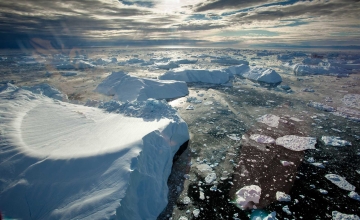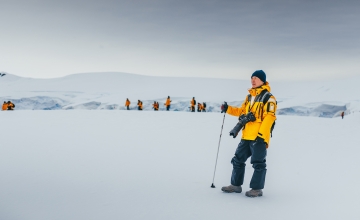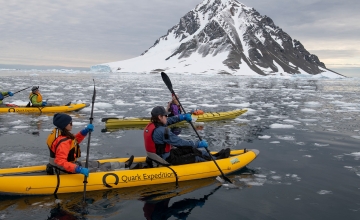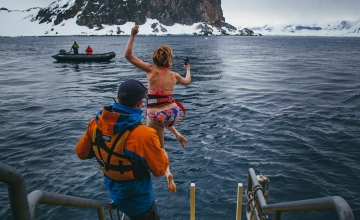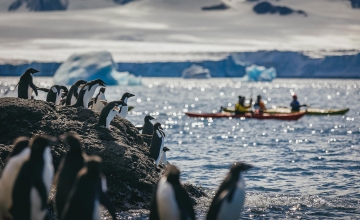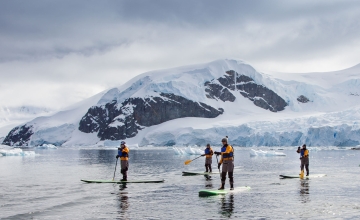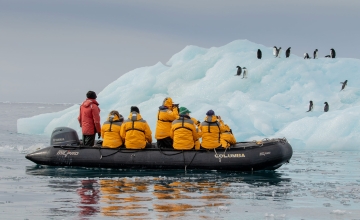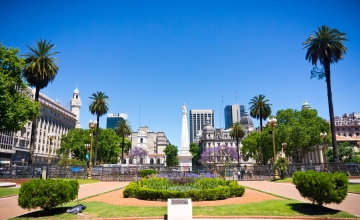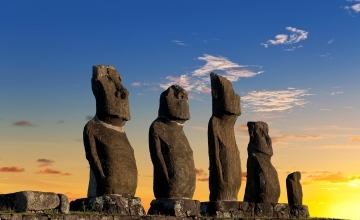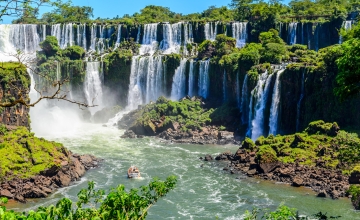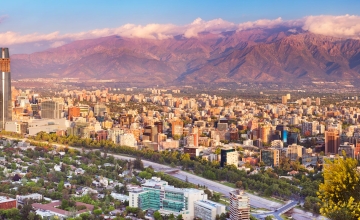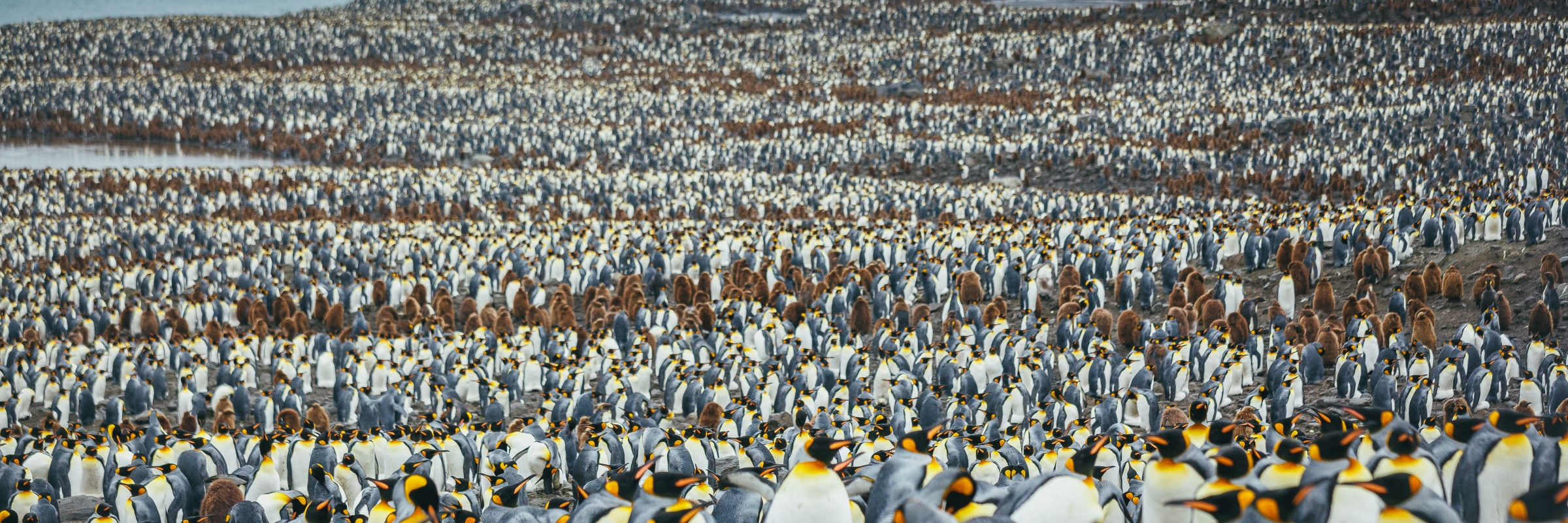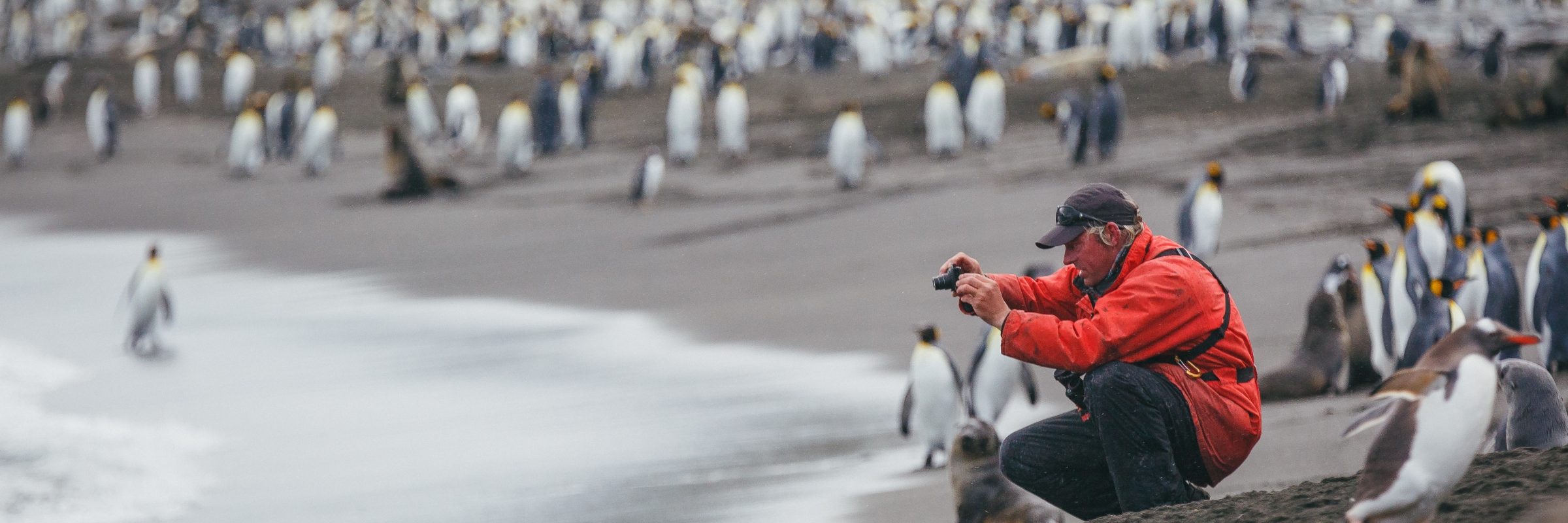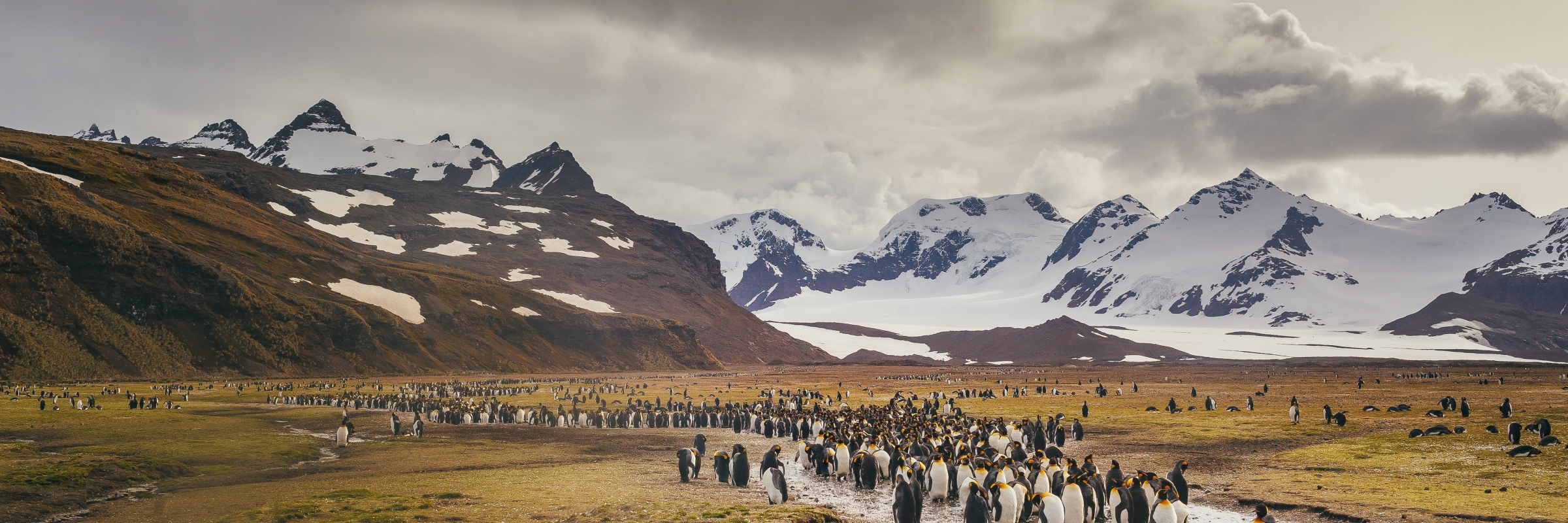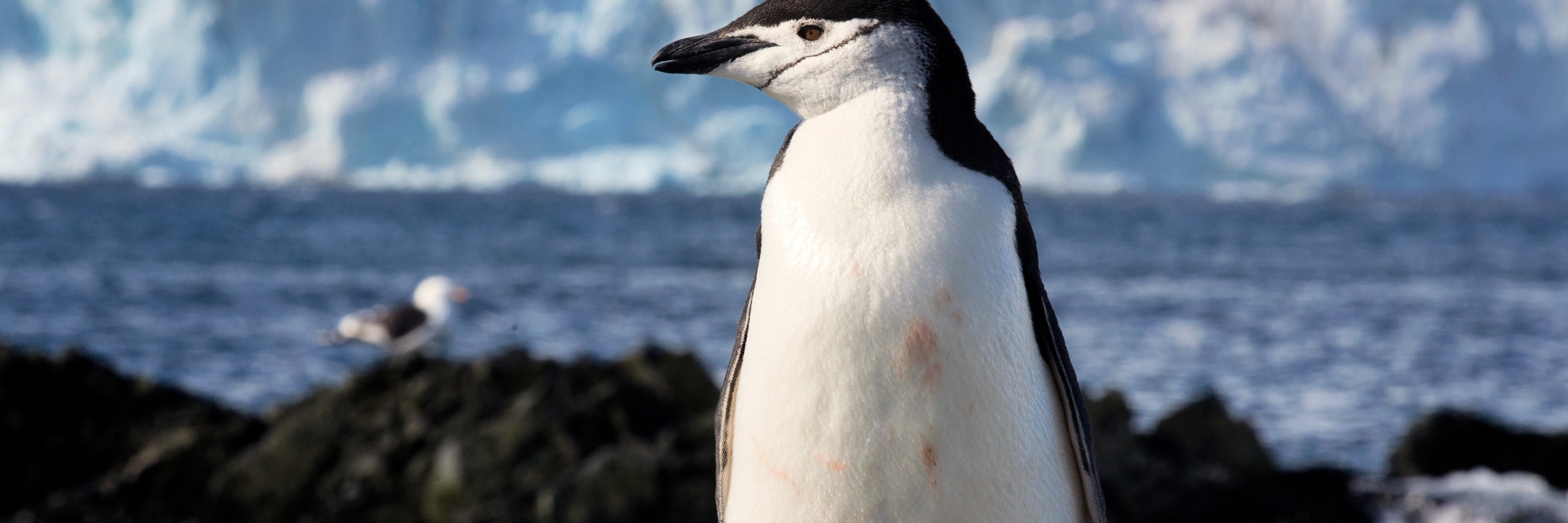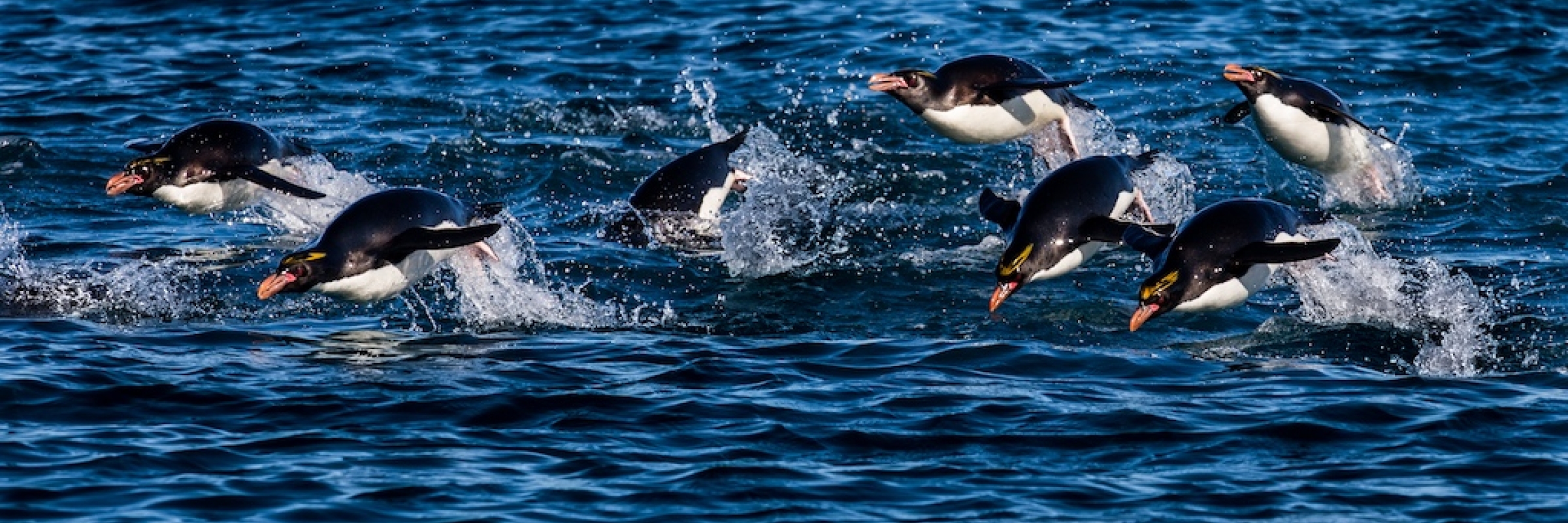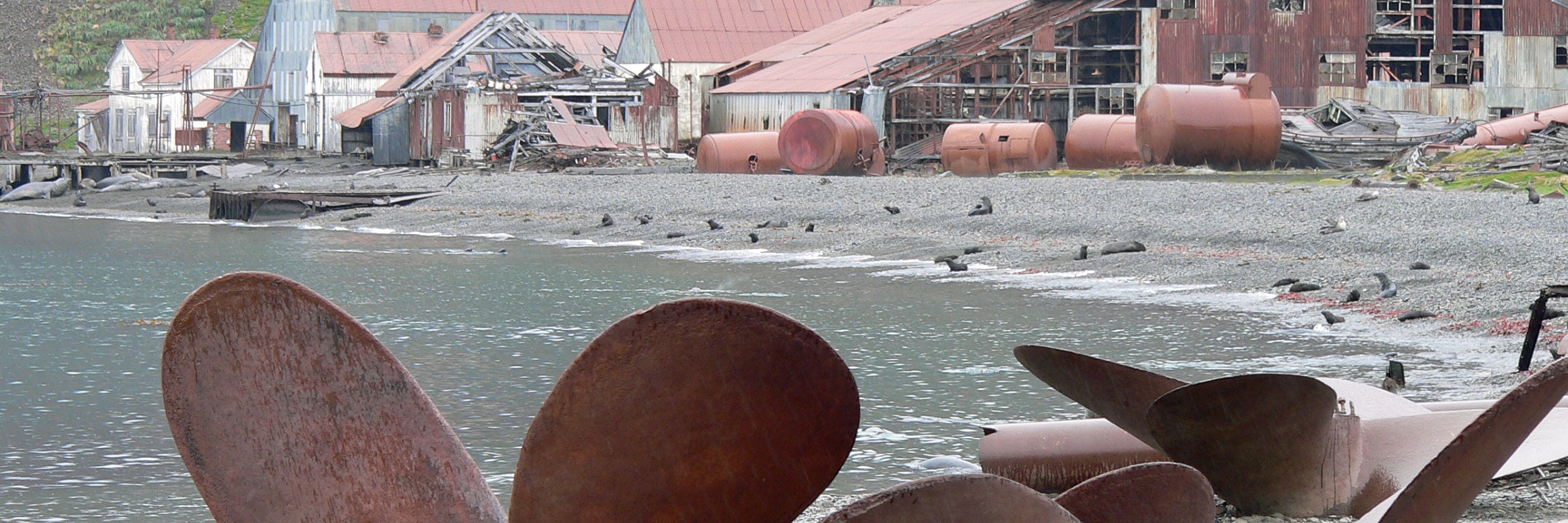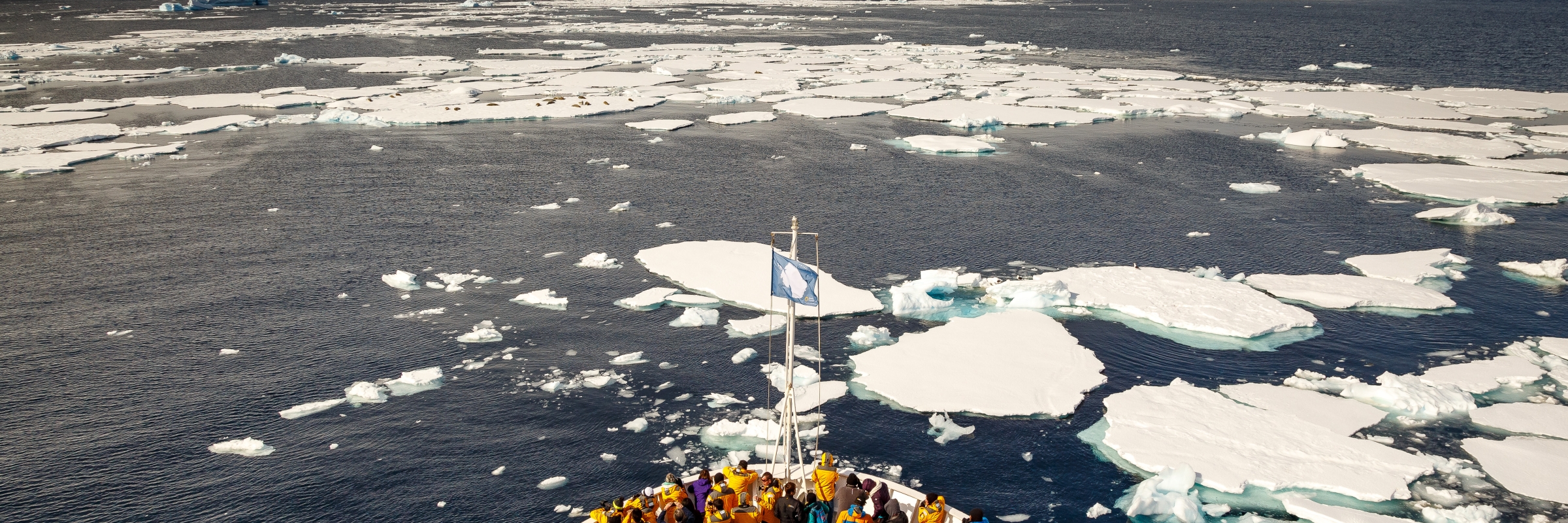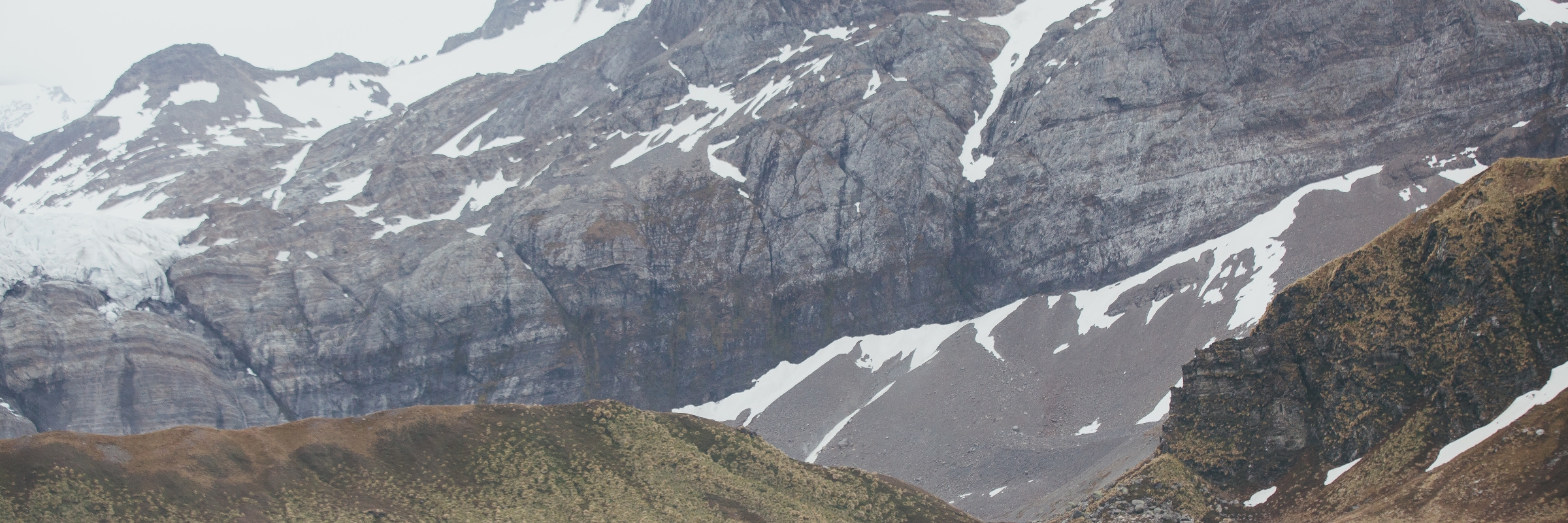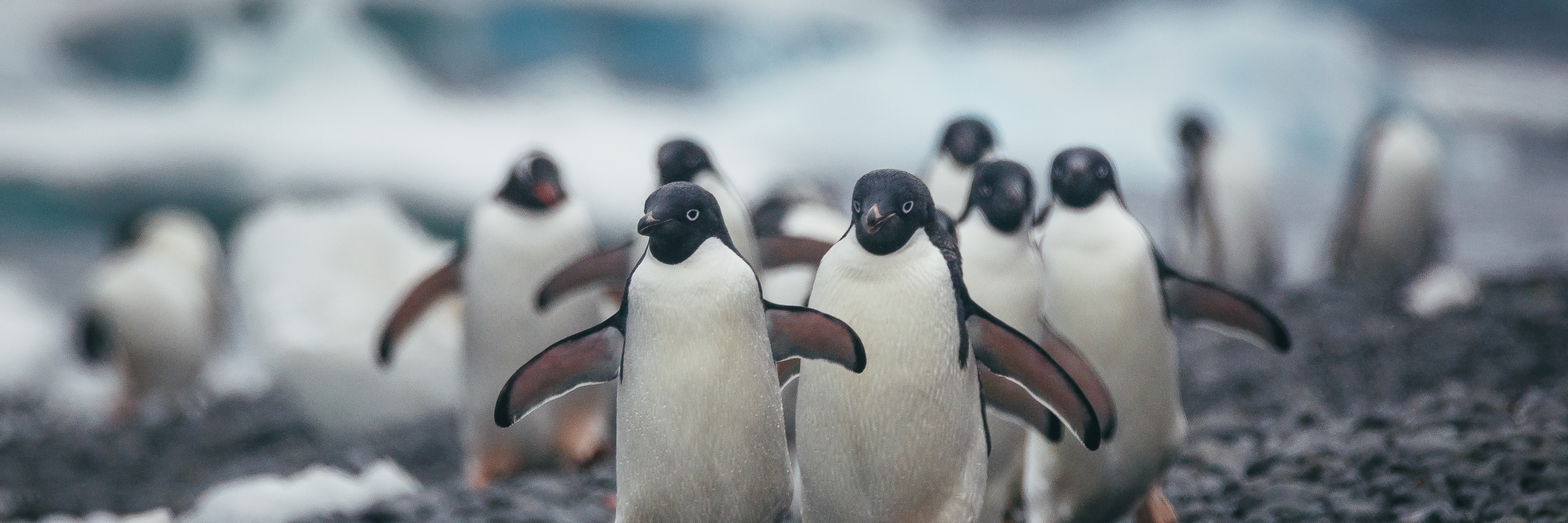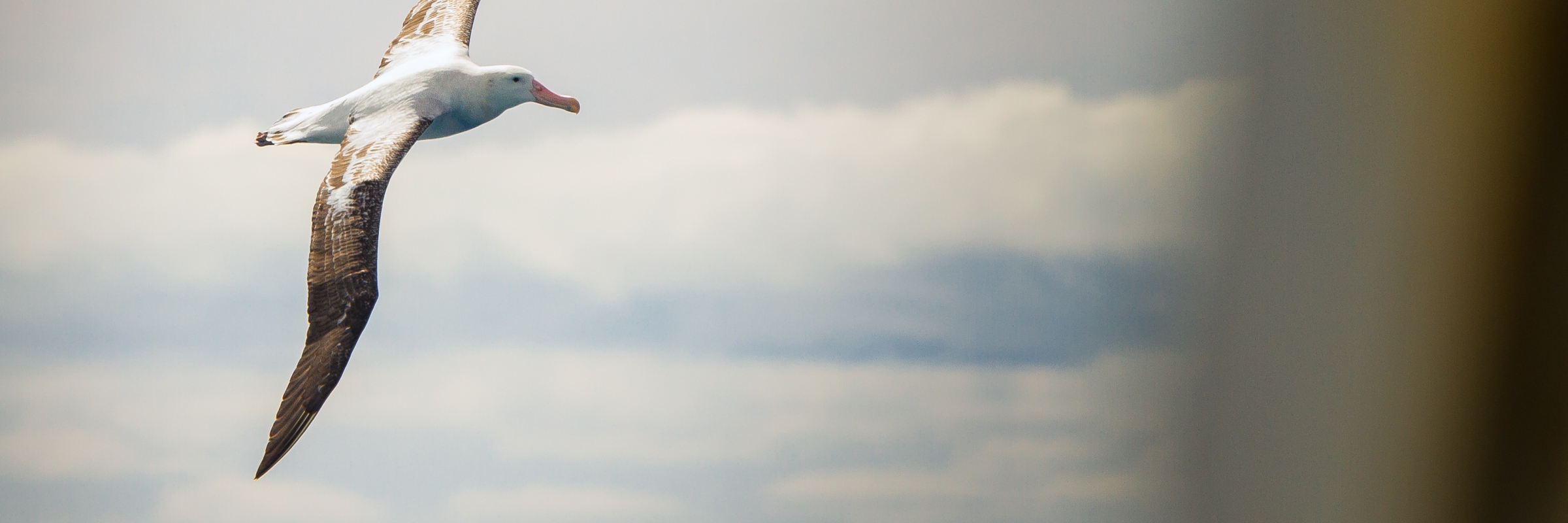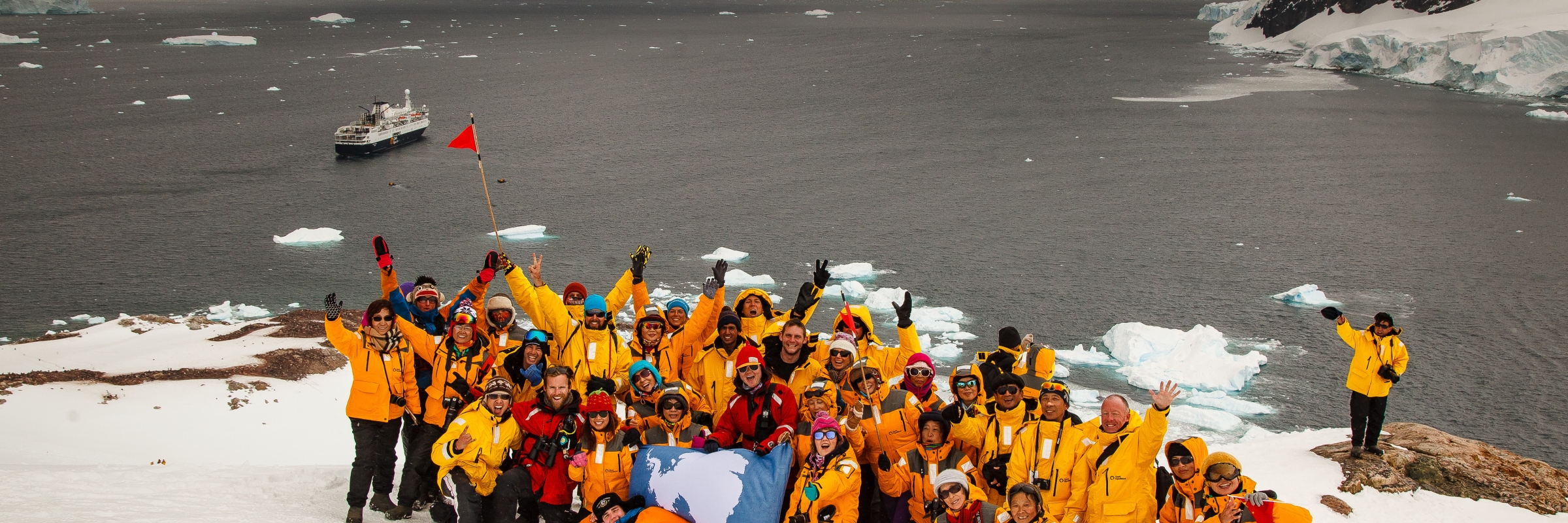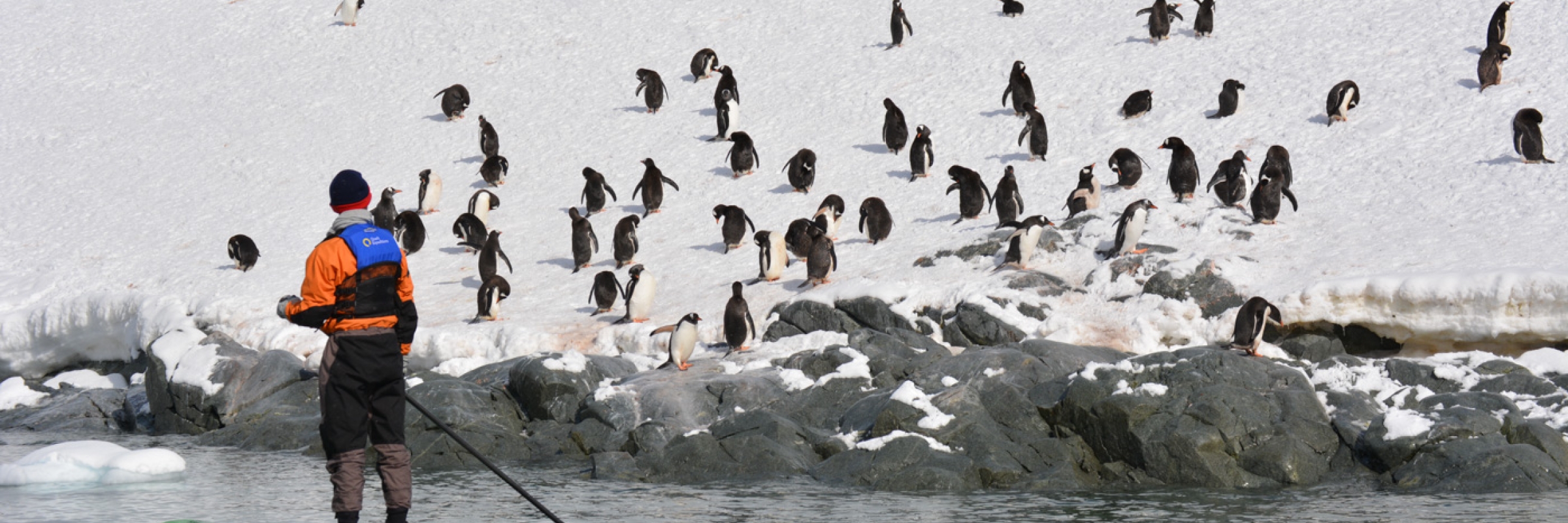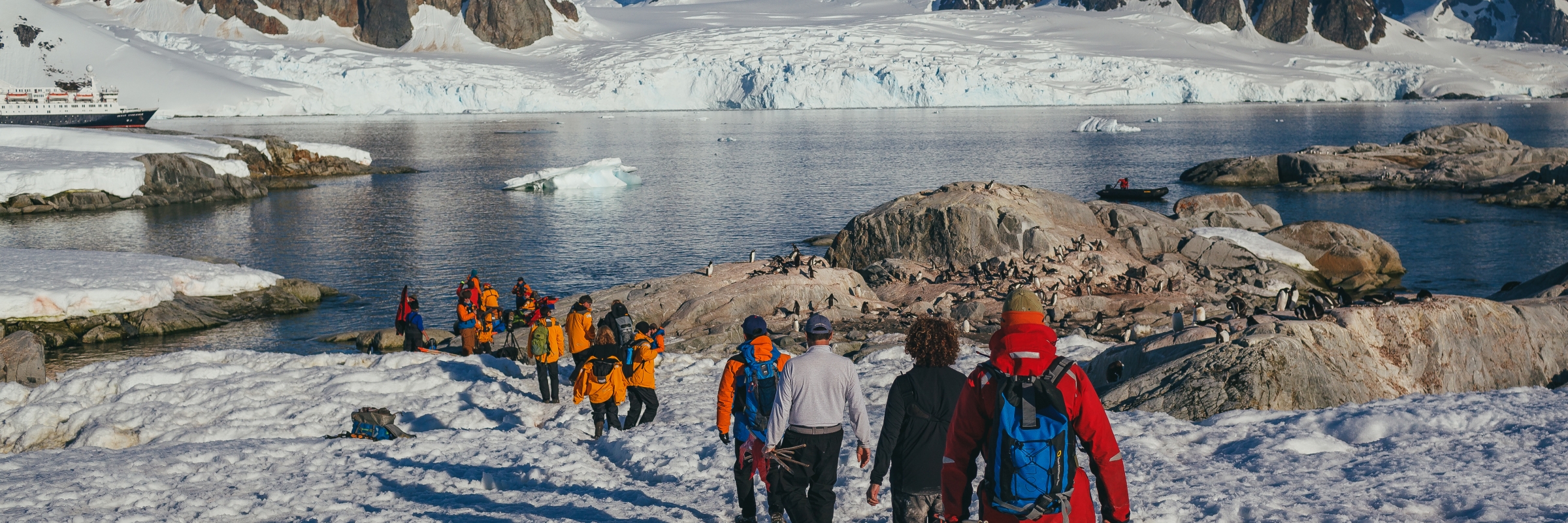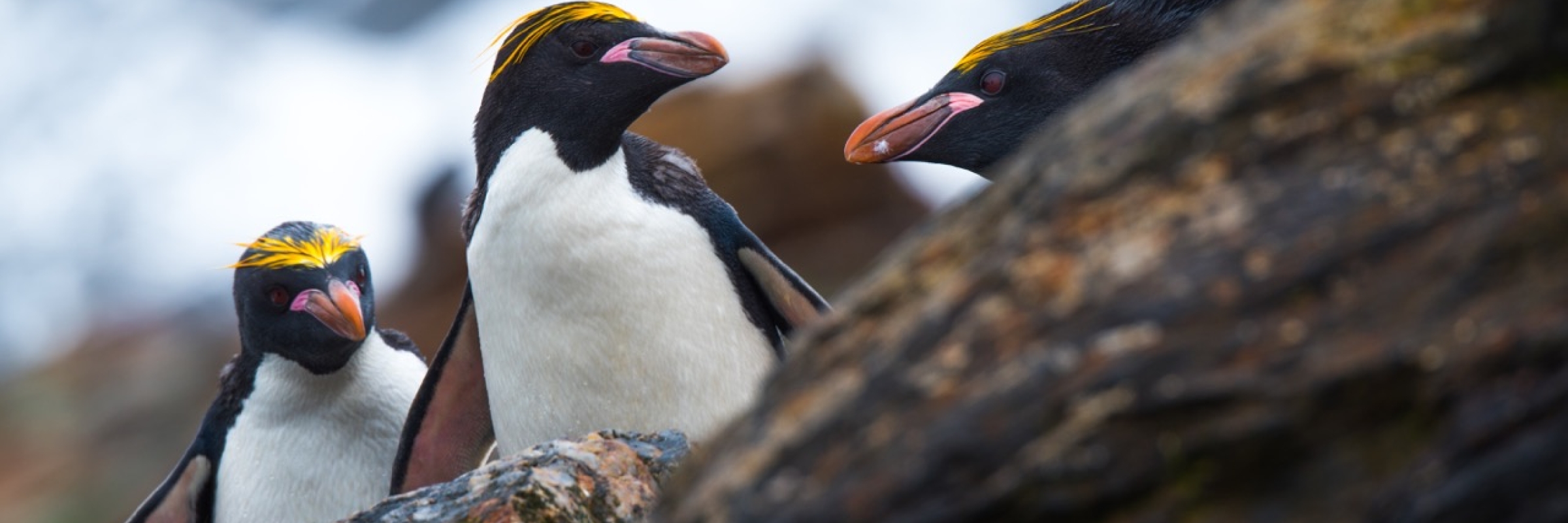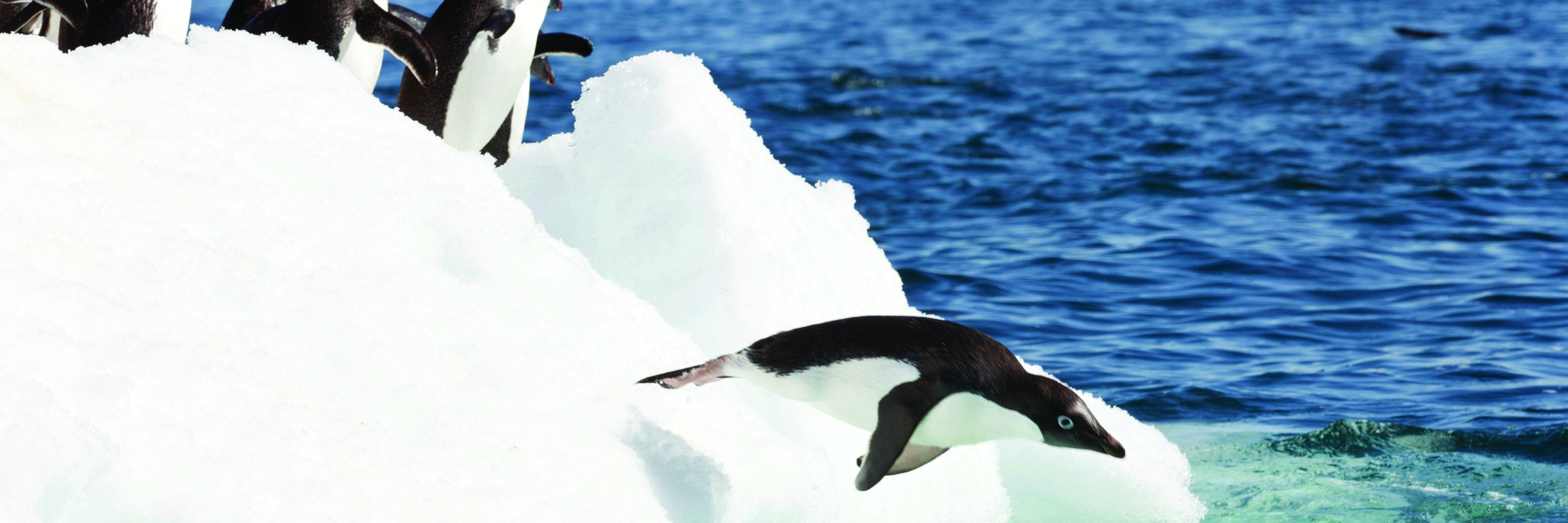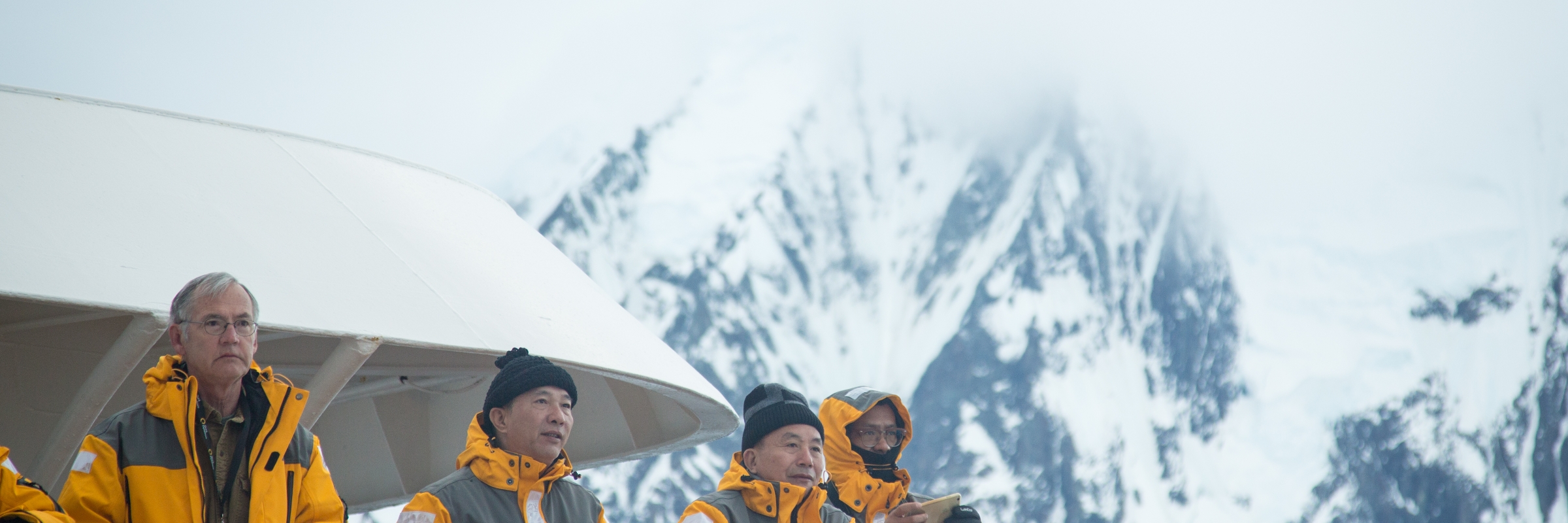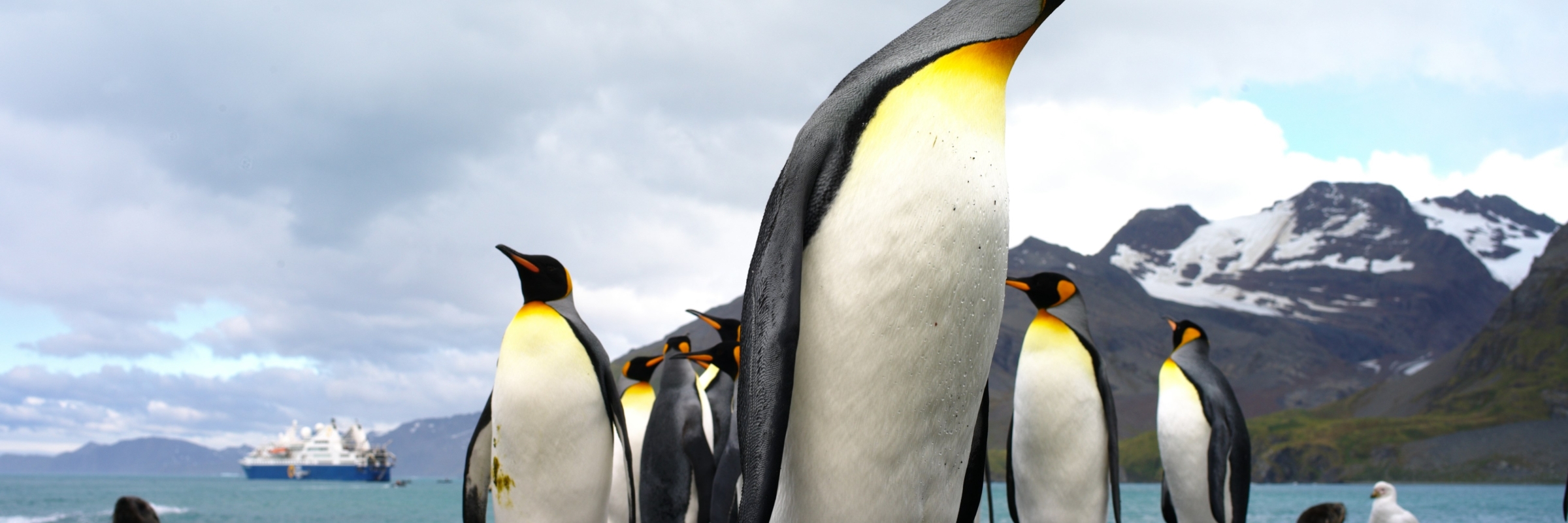You will begin your journey in Ushuaia, a small but bustling port at the tip of South America. It’s the ideal gateway for you to explore the southern extent of Patagonia while preparing for your adventure ahead. Get active in the mountains or enjoy handcrafted chocolate at a café in town.
South Georgia and Antarctic Peninsula: Penguin Safari
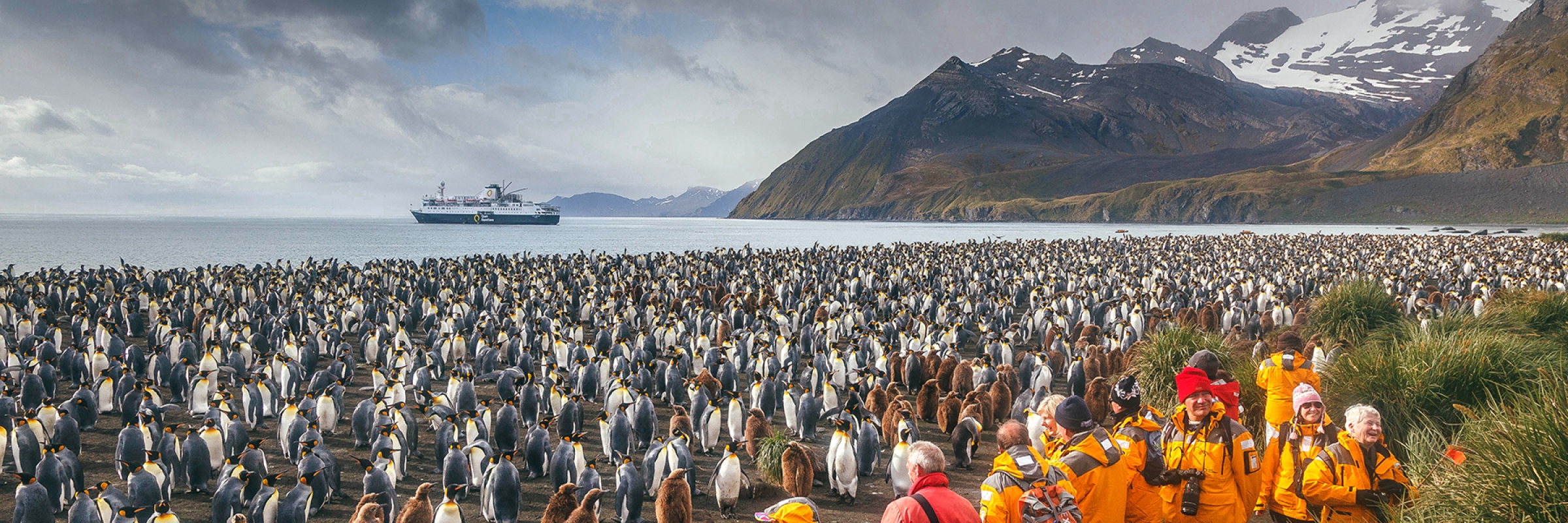
Our South Georgia and Antarctica: Penguin Safari itinerary is the fastest way to get to the seldom visited South Georgia Island while also setting foot on the 7th continent. As we set sail, photograph massive albatross and beautiful pintado petrels as they swoop and soar around the ship, guiding us toward South Georgia. Beaches teeming with king penguins and elephant seals greet us on this fabled island, where we’ll pay our respects to famed explorer Sir Ernest Shackleton. Antarctica awaits, with its soaring peaks and staggering expanse. Go further into the Antarctic sea on a Zodiac, experience the rugged peninsula from a sea kayak, undertake an exhilarating hike up a sparkling glacier, or share an endearingly comical moment with an inquisitive gentoo, chinstrap and Adélie penguin. In these ways and countless others, Antarctica will amaze, surprise and delight.
Starting in 2021, this itinerary allows you to the opportunity to experience our pioneering new vessel, Ultramarine. This purpose-built vessel is designed to extend the boundaries of polar exploration and offer an unmatched Antarctic experience, including a flightseeing tour you’ll never forget and a range of adventure options more extensive than any other ship in its class.
- If you’re travelling onboard Ultramarine in 2021, arrive in Buenos Aires, Argentina and let us take care of the rest of your journey
- See South Georgia’s incredible wildlife, including 30 breeding bird species and four penguin species
- Follow in the wake of Sir Ernest Shackleton’s perilous voyages to South Georgia and pause for a moment at his grave site
- Explore the Antarctic Peninsula by ship, Zodiac and foot
- Learn about Antarctica’s unique geology, history and wildlife with our onboard lecturers
- Immerse yourself in the icy realm of the Antarctic, with an optional paddling excursion
- Enjoy helicopter flightseeing if you’re travelling onboard Ultramarine in 2021 and experience a unique perspective of the Antarctic Peninsula
行程
Day 1 — Ushuaia, Argentina
Day 2 — Embark
Embarkation will occur in the late afternoon, after which your vessel will sail down the historic Beagle Channel, which transects the Tierra del Fuego archipelago in the extreme south of South America. Expect an air of anticipation as you depart!
Days 3 to 6 — At Sea
There are many activities to keep you engaged while you are at sea. Learn to identify seabirds that glide alongside the ship, or attend dynamic presentations by your Expedition Team. You will be prepped on safety procedures for Zodiac cruises and shore landings, and also be given instructions for getting the most out of your optional sea kayaking adventures (extra cost), a truly intimate way to experience Antarctica.
If conditions are right, the first indication that you are approaching South Georgia is the sight of birds around a group of rocky spires called Shag Rocks. Have your binoculars and cameras ready to capture these rocky spires rising out of the icy ocean waters. Shags and prions often rest here, and due to nutrient rich upwellings around the rocks it can be a good place to keep a lookout for whales.
Days 7 and 8 — South Georgia
After enjoying South Georgia from a distance, we’ll head toward its numerous beaches to find a bay for your first excursion. Landing sites are varied, largely determined by the weather conditions of your voyage. Whichever sites we visit, they’ll provide you with wildlife encounters unrivaled anywhere else on earth.
South Georgia is one of the most fertile breeding grounds in the world for sub-Antarctic wildlife, with beaches blanketed with penguins and seals. It won’t take you long to realize that you are in a bird paradise, as burrowing seabirds, albatross and petrels can be seen in abundance.
You’ll find that South Georgia, once a popular base for whalers and sealers, is also scattered with abandoned relics and evidence of human activity from centuries gone by. Your Expedition Team will help bring those days to life while you visit old whaling stations and enjoy presentations on the South Georgia of then and now.
One of the most significant sites you will visit on the island is Grytviken. This settlement is the first whaling stations established in sub-Antarctic waters. Many travelers find that this place has a special appeal, as it is the site of the grave of Sir Ernest Shackleton, one of the most famous Antarctic explorers.
Days 9 and 10 — At Sea
Say goodbye to the king penguins, as your next destination is Antarctica! Your days at sea are filled with presentations and workshops led by your Expedition Team, who will prepare you for the wildlife and landscapes that will surround you upon your arrival
Days 11 to 13 — Antarctic Peninsula
The most common reaction upon reaching the White Continent is a sense of reverence and awe. The experience is hard to put into words, since few places are as untouched and enduring as Antarctica.
You will discover that Antarctica is a land of extremes. At one moment you’ll be overcome with a feeling of complete isolation and silence, and at the next moment you’ll be inspired by nature as a calving glacier crashes into a brilliant blue sea or a penguin waddles by to inspect your footwear.
Your Expedition Team will take care of you at each excursion, whether you are Zodiac cruising, visiting a historical site or consorting with penguin colonies. Chinstrap, Adélie and gentoo penguins are found here, along with Weddell, fur, crabeater and leopard seals. Keep a lookout for Antarctic whales, such as minkes, while on a Zodiac cruise. Each day and each excursion will present a new collection of creatures to delight you and keep your camera busy.
As exciting as the Zodiac excursions and landings are, perhaps you’ll treat yourself to an extra-special Antarctic experience by partaking in an optional paddling excursion (at an extra cost) or cast reason aside and jump into Antarctic waters for the Polar Plunge!
Days 14 and 15 — Crossing the Drake Passage
After more than a dozen days of unique wildlife encounters and remarkable landscapes, your journey home begins. Crossing the Drake is your unofficial rite of passage. Spend time on deck watching for seabirds and whales, enjoy presentations by your Expedition Team, or simply relax and reminisce about your experiences.
Day 16 — Disembark in Ushuaia
You will arrive in Ushuaia in the morning, which allows for you to continue your adventure onward or catch your flights home.

Day 1 — Arrive in Buenos Aires, Argentina
You may arrive in Buenos Aires at any time during Day 1 of your itinerary. Upon arriving in this splendid city, known for its architecture and rich European heritage, you will independently transfer to your group hotel (pre-expedition hotel night included in mandatory transfer package).
Day 2 — Fly to Ushuaia and Embark
After an early breakfast at the hotel, the group will transfer to the airport and board our private charter flight to Ushuaia, Argentina.
Upon arrival, you will be transferred from the airport to a central downtown location to have some time on your own to explore this quaint port town before making your way to the pier.
After a late afternoon embarkation, you will sail along the historic Beagle Channel, which transects the Tierra del Fuego archipelago in the extreme south of South America. Expect an air of anticipation as you depart!
Days 3 to 6 — At Sea
There are many activities available to keep you engaged while you are at sea. Learn to identify seabirds that glide alongside the ship, or attend dynamic presentations by your Expedition Team. You will be prepped on safety procedures for Zodiac cruises and shore landings, and also be given instructions for getting the most out of your optional sea kayaking adventures (extra cost), a truly intimate way to experience Antarctica.
If conditions are right, the first indication that you are approaching South Georgia is the sight of birds around a group of rocky spires called Shag Rocks. Have your binoculars and cameras ready to capture these rocky spires rising out of the icy ocean waters. Shags and prions often rest here, and due to nutrient rich upwellings around the rocks it can be a good place to keep a lookout for whales.
Days 7 and 8 — South Georgia
After enjoying South Georgia from a distance, we’ll head toward its numerous beaches to find a bay for your first excursion. Landing sites are varied, largely determined by the weather conditions of your voyage. Whichever sites we visit, they’ll provide you with wildlife encounters unrivaled anywhere else on earth.
South Georgia is one of the most fertile breeding grounds in the world for sub-Antarctic wildlife, with beaches blanketed with penguins and seals. It won’t take you long to realize that you are in a bird paradise, as burrowing seabirds, albatross and petrels can be seen in abundance.
You’ll find that South Georgia, once a popular base for whalers and sealers, is also scattered with abandoned relics and evidence of human activity from centuries gone by. Your Expedition Team will help bring those days to life while you visit old whaling stations and enjoy presentations on the South Georgia of then and now.
One of the most significant sites you will visit on the island is Grytviken. This settlement is the first whaling stations established in sub-Antarctic waters. Many travelers find that this place has a special appeal, as it is the site of the grave of Sir Ernest Shackleton, one of the most famous Antarctic explorers.
Days 9 and 10 — At Sea
Say goodbye to the king penguins, as your next destination is Antarctica! Your days at sea are filled with presentations and workshops led by your Expedition Team, who will prepare you for the wildlife and landscapes that will surround you upon your arrival.
Days 11 to 13 — Antarctic Peninsula
The most common reaction upon reaching the White Continent is a sense of reverence and awe. The experience is hard to put into words, since few places are as untouched and enduring as Antarctica.
You will discover that Antarctica is a land of extremes. At one moment you’ll be overcome with a feeling of complete isolation and silence, and at the next moment you’ll be inspired by nature as a calving glacier crashes into a brilliant blue sea or a penguin waddles by to inspect your footwear.
Your Expedition Team will take care of you at each excursion, whether you are Zodiac cruising, visiting a historical site or consorting with penguin colonies. Chinstrap, Adélie and gentoo penguins are found here, along with Weddell, fur, crabeater and leopard seals. Keep a lookout for Antarctic whales, such as minkes, while on a Zodiac cruise. Each day and each excursion will present a new collection of creatures to delight you and keep your camera busy.
As exciting as the Zodiac excursions and landings are, perhaps you’ll treat yourself to an extra-special Antarctic experience by partaking in an optional paddling excursion (at an extra cost) or cast reason aside and jump into Antarctic waters for the Polar Plunge!
Days 14 and 15 — Crossing the Drake Passage
After more than a dozen days of unique wildlife encounters and remarkable landscapes, your journey home begins. Crossing the Drake is your unofficial rite of passage. Spend time on deck watching for seabirds and whales, enjoy presentations by your Expedition Team, or simply relax and reminisce about your experiences.
Day 16 — Disembark in Ushuaia and Fly to Buenos Aires
You will arrive in Ushuaia in the morning and disembark after breakfast. The mandatory transfer package includes a little taste of Patagonia with a Tierra del Fuego National Park tour before transferring to the airport for the return group charter flight to Buenos Aires.

Day 1 — Ushuaia, Argentina
You will begin your journey in Ushuaia, a small but bustling port at the tip of South America. It’s the ideal gateway for you to explore the southern extent of Patagonia while preparing for your adventure ahead. Get active in the mountains or enjoy handcrafted chocolate at a café in town.
Day 2 — Embark
Embarkation will occur in the late afternoon, after which your vessel will sail down the historic Beagle Channel, which transects the Tierra del Fuego archipelago in the extreme south of South America. Expect an air of anticipation as you depart!
Days 3 to 6 — At Sea
There are many activities to keep you engaged while you are at sea. Learn to identify seabirds that glide alongside the ship, or attend dynamic presentations by your Expedition Team. You will be prepped on safety procedures for Zodiac cruises and shore landings, and also be given instructions for getting the most out of your optional sea kayaking adventures (extra cost), a truly intimate way to experience Antarctica.
If conditions are right, the first indication that you are approaching South Georgia is the sight of birds around a group of rocky spires called Shag Rocks. Have your binoculars and cameras ready to capture these rocky spires rising out of the icy ocean waters. Shags and prions often rest here, and due to nutrient rich upwellings around the rocks it can be a good place to keep a lookout for whales.
Days 7 and 8 — South Georgia
After enjoying South Georgia from a distance, we’ll head toward its numerous beaches to find a bay for your first excursion. Landing sites are varied, largely determined by the weather conditions of your voyage. Whichever sites we visit, they’ll provide you with wildlife encounters unrivaled anywhere else on earth.
South Georgia is one of the most fertile breeding grounds in the world for sub-Antarctic wildlife, with beaches blanketed with penguins and seals. It won’t take you long to realize that you are in a bird paradise, as burrowing seabirds, albatross and petrels can be seen in abundance.
You’ll find that South Georgia, once a popular base for whalers and sealers, is also scattered with abandoned relics and evidence of human activity from centuries gone by. Your Expedition Team will help bring those days to life while you visit old whaling stations and enjoy presentations on the South Georgia of then and now.
One of the most significant sites you will visit on the island is Grytviken. This settlement is the first whaling stations established in sub-Antarctic waters. Many travelers find that this place has a special appeal, as it is the site of the grave of Sir Ernest Shackleton, one of the most famous Antarctic explorers.
Days 9 and 10 — At Sea
Say goodbye to the king penguins, as your next destination is Antarctica! Your days at sea are filled with presentations and workshops led by your Expedition Team, who will prepare you for the wildlife and landscapes that will surround you upon your arrival
Days 11 to 13 — Antarctic Peninsula
The most common reaction upon reaching the White Continent is a sense of reverence and awe. The experience is hard to put into words, since few places are as untouched and enduring as Antarctica.
You will discover that Antarctica is a land of extremes. At one moment you’ll be overcome with a feeling of complete isolation and silence, and at the next moment you’ll be inspired by nature as a calving glacier crashes into a brilliant blue sea or a penguin waddles by to inspect your footwear.
Your Expedition Team will take care of you at each excursion, whether you are Zodiac cruising, visiting a historical site or consorting with penguin colonies. Chinstrap, Adélie and gentoo penguins are found here, along with Weddell, fur, crabeater and leopard seals. Keep a lookout for Antarctic whales, such as minkes, while on a Zodiac cruise. Each day and each excursion will present a new collection of creatures to delight you and keep your camera busy.
As exciting as the Zodiac excursions and landings are, perhaps you’ll treat yourself to an extra-special Antarctic experience by partaking in an optional paddling excursion (at an extra cost) or cast reason aside and jump into Antarctic waters for the Polar Plunge!
Days 14 and 15 — Crossing the Drake Passage
After more than a dozen days of unique wildlife encounters and remarkable landscapes, your journey home begins. Crossing the Drake is your unofficial rite of passage. Spend time on deck watching for seabirds and whales, enjoy presentations by your Expedition Team, or simply relax and reminisce about your experiences.
Day 16 — Disembark in Ushuaia
You will arrive in Ushuaia in the morning, which allows for you to continue your adventure onward or catch your flights home.

Day 1 — Arrive in Buenos Aires, Argentina
You may arrive in Buenos Aires at any time during Day 1 of your itinerary. Upon arriving in this splendid city, known for its architecture and rich European heritage, you will independently transfer to your group hotel (pre-expedition hotel night included in mandatory transfer package).
Day 2 — Fly to Ushuaia and Embark
After an early breakfast at the hotel, the group will transfer to the airport and board our private charter flight to Ushuaia, Argentina.
Upon arrival, you will be transferred from the airport to a central downtown location to have some time on your own to explore this quaint port town before making your way to the pier.
After a late afternoon embarkation, you will sail along the historic Beagle Channel, which transects the Tierra del Fuego archipelago in the extreme south of South America. Expect an air of anticipation as you depart!
Days 3 to 6 — At Sea
There are many activities available to keep you engaged while you are at sea. Learn to identify seabirds that glide alongside the ship, or attend dynamic presentations by your Expedition Team. You will be prepped on safety procedures for Zodiac cruises and shore landings, and also be given instructions for getting the most out of your optional sea kayaking adventures (extra cost), a truly intimate way to experience Antarctica.
If conditions are right, the first indication that you are approaching South Georgia is the sight of birds around a group of rocky spires called Shag Rocks. Have your binoculars and cameras ready to capture these rocky spires rising out of the icy ocean waters. Shags and prions often rest here, and due to nutrient rich upwellings around the rocks it can be a good place to keep a lookout for whales.
Days 7 and 8 — South Georgia
After enjoying South Georgia from a distance, we’ll head toward its numerous beaches to find a bay for your first excursion. Landing sites are varied, largely determined by the weather conditions of your voyage. Whichever sites we visit, they’ll provide you with wildlife encounters unrivaled anywhere else on earth.
South Georgia is one of the most fertile breeding grounds in the world for sub-Antarctic wildlife, with beaches blanketed with penguins and seals. It won’t take you long to realize that you are in a bird paradise, as burrowing seabirds, albatross and petrels can be seen in abundance.
You’ll find that South Georgia, once a popular base for whalers and sealers, is also scattered with abandoned relics and evidence of human activity from centuries gone by. Your Expedition Team will help bring those days to life while you visit old whaling stations and enjoy presentations on the South Georgia of then and now.
One of the most significant sites you will visit on the island is Grytviken. This settlement is the first whaling stations established in sub-Antarctic waters. Many travelers find that this place has a special appeal, as it is the site of the grave of Sir Ernest Shackleton, one of the most famous Antarctic explorers.
Days 9 and 10 — At Sea
Say goodbye to the king penguins, as your next destination is Antarctica! Your days at sea are filled with presentations and workshops led by your Expedition Team, who will prepare you for the wildlife and landscapes that will surround you upon your arrival.
Days 11 to 13 — Antarctic Peninsula
The most common reaction upon reaching the White Continent is a sense of reverence and awe. The experience is hard to put into words, since few places are as untouched and enduring as Antarctica.
You will discover that Antarctica is a land of extremes. At one moment you’ll be overcome with a feeling of complete isolation and silence, and at the next moment you’ll be inspired by nature as a calving glacier crashes into a brilliant blue sea or a penguin waddles by to inspect your footwear.
Your Expedition Team will take care of you at each excursion, whether you are Zodiac cruising, visiting a historical site or consorting with penguin colonies. Chinstrap, Adélie and gentoo penguins are found here, along with Weddell, fur, crabeater and leopard seals. Keep a lookout for Antarctic whales, such as minkes, while on a Zodiac cruise. Each day and each excursion will present a new collection of creatures to delight you and keep your camera busy.
As exciting as the Zodiac excursions and landings are, perhaps you’ll treat yourself to an extra-special Antarctic experience by partaking in an optional paddling excursion (at an extra cost) or cast reason aside and jump into Antarctic waters for the Polar Plunge!
Days 14 and 15 — Crossing the Drake Passage
After more than a dozen days of unique wildlife encounters and remarkable landscapes, your journey home begins. Crossing the Drake is your unofficial rite of passage. Spend time on deck watching for seabirds and whales, enjoy presentations by your Expedition Team, or simply relax and reminisce about your experiences.
Day 16 — Disembark in Ushuaia and Fly to Buenos Aires
You will arrive in Ushuaia in the morning and disembark after breakfast. The mandatory transfer package includes a little taste of Patagonia with a Tierra del Fuego National Park tour before transferring to the airport for the return group charter flight to Buenos Aires.

